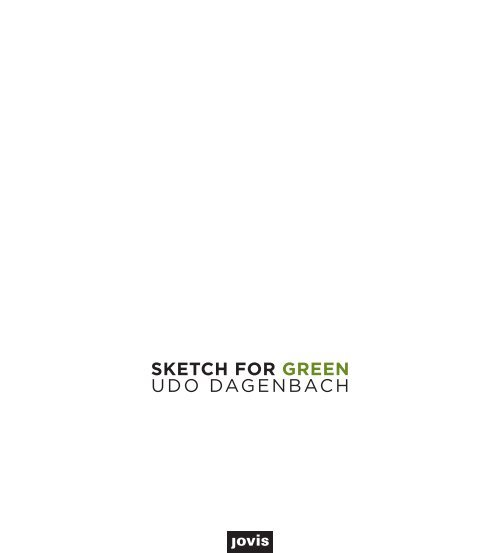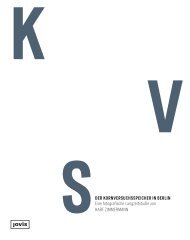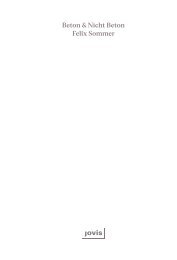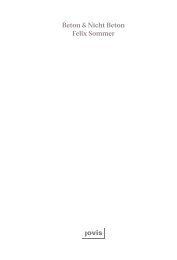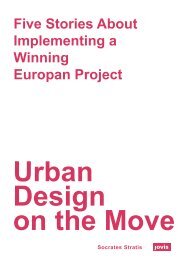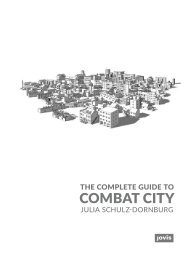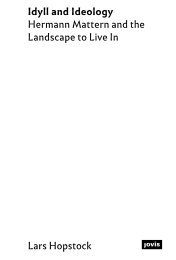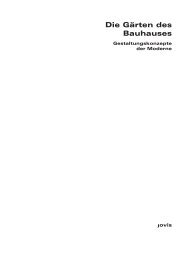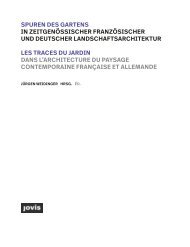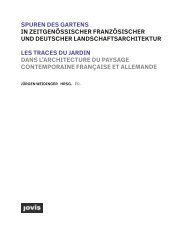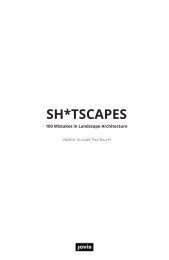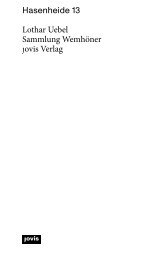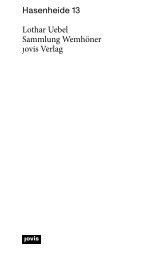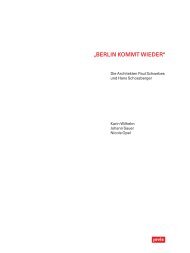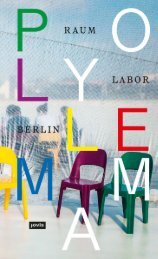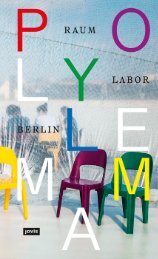Sketch for Green
ISBN 978-3-86859-632-8
ISBN 978-3-86859-632-8
Create successful ePaper yourself
Turn your PDF publications into a flip-book with our unique Google optimized e-Paper software.
SKETCH FOR GREEN<br />
Udo dagenbach
IMPRINT<br />
© 2020 by jovis Verlag gmbh<br />
Texts by kind permission of the author.<br />
Pictures by kind permission of the photographers/<br />
holders of the picture rights.<br />
all rights reserved.<br />
cover and drawings: Udo dagenbach<br />
Photographs: Udo dagenbach, except from p. 131, 179, 187–189, 193<br />
Idea:<br />
concept and editing:<br />
Translation and copy editing:<br />
design and setting:<br />
Lithography:<br />
Udo dagenbach<br />
bettina held<br />
Ray Malone, christina Wahle<br />
Ursula Steinheuer, Minkyung choi<br />
deSIgnPReSS gMbh<br />
benzstraße 39, d 71272 Renningen, germany<br />
Printed in the european Union.<br />
bibliographic in<strong>for</strong>mation published by the<br />
deutsche nationalbibliothek.<br />
The deutsche nationalbibliothek lists this publication<br />
in the deutsche nationalbibliografie.<br />
detailed bibliographic data are available on the Internet<br />
at http://dnb.d-nb.de.<br />
jovis Verlag gmbh<br />
Kurfürstenstraße 15/16<br />
10785 berlin<br />
www.jovis.de<br />
jovis books are available worldwide in select<br />
bookstores. Please contact your nearest bookseller<br />
or visit www.jovis.de <strong>for</strong> in<strong>for</strong>mation concerning your<br />
local distribution.<br />
ISbn 978-3-86859-632-8<br />
4
TABLE OF CONTENTS<br />
7 FROM MY<br />
SKETCHBOOKS<br />
Udo dagenbach<br />
11 DRAWING WALK<br />
bettina held<br />
23 SCULPTURES<br />
+ IDEAS IN STONE<br />
24 Ideas in Stone<br />
48 Stone Sculptures<br />
54 Plant Sculptures<br />
70 Stone–Plant Sculptures<br />
86 other Sculptures<br />
101 LANDSCAPE<br />
ARCHITECTURE<br />
+ COMPETITIONS<br />
102 competitions<br />
112 Show gardens + exhibitions<br />
118 Landscape architecture<br />
195 CATALOG<br />
SCULPTURES<br />
+ IDEAS IN STONE<br />
197 Ideas in Stone<br />
200 Stone Sculptures<br />
202 Plant Sculptures<br />
203 Stone–Plant Sculptures<br />
206 other Sculptures<br />
LANDSCAPE<br />
ARCHITECTURE<br />
+ COMPETITIONS<br />
209 competitions<br />
210 Show gardens + exhibitions<br />
212 Landscape architecture<br />
MIXED THEMES<br />
218 graphic art<br />
221 Sculpture<br />
223 applied art<br />
157 MIXED THEMES<br />
227 VITA<br />
158 graphic art<br />
178 Sculpture<br />
186 applied art<br />
5
“Curiosity<br />
is the currency of luck.”<br />
Udo dagenbach<br />
6
FROM MY SKETCHBOOKS<br />
Udo dagenbach<br />
<strong>Sketch</strong>ing is a very individual way to<br />
express your ideas.<br />
It always shows your vision. If you<br />
look back on the drawings you have<br />
done over a long period, you recognize<br />
a kind of common thread that<br />
links all the designs and ideas.<br />
In 2017, I decided to review all my<br />
sketches done from around 1974 until<br />
now and present a selection of them<br />
in a book.<br />
It seems that the technical standard<br />
of digital drawing pencils has meanwhile<br />
reached such a high standard,<br />
that they will replace analog drawings<br />
very soon.<br />
There<strong>for</strong>e, I see my drawings as relics<br />
of a dying work method.<br />
I always refused to draw with the mouse,<br />
as I regarded it as a very strange and<br />
unsatisfying instrument. The connection<br />
between hand and brain was not as it<br />
should be. For hundreds of thousands<br />
of years mankind relied on its ability to<br />
shape its environment with its hands—<br />
developing analog tools as extended<br />
hands—but still depending on a good<br />
hand-brain coordination. The mouse<br />
has always lacked this connection.<br />
With the modern pencil tools we can<br />
return to the analog structure of our<br />
archaic abilities, and yet advance to<br />
the incredible new chances the digital<br />
world is providing <strong>for</strong> our creative<br />
work.<br />
I have never regarded my drawings as<br />
an art in itself—my drawings are expressions<br />
of ideas I intend to realize<br />
somewhere in the landscape, or they<br />
show how I read landscape and trans<strong>for</strong>m<br />
it into a sketch.<br />
For 40 years I have been working in<br />
the field of landscaping, and <strong>for</strong> 30<br />
years I have been working with glaßer<br />
und dagenbach landscape architects<br />
in berlin. as you can imagine, lots of<br />
ideas, projects, competitions have been<br />
done during this time. Many of them<br />
have not been realized or chosen to<br />
be awarded in a competition.<br />
So they disappear unpublished, although<br />
many of them are worth being presented.<br />
In a regular project, process sketches<br />
are often only the first steps, which later<br />
are processed into renderings, animations<br />
developed with Photoshop.<br />
The process of design is hardly ever<br />
completely documented. nobody shows<br />
a false design path, which could have<br />
been interesting in another project.<br />
7
on. Maybe technical data and dimensions<br />
have already been specified, or<br />
indications as to implementation, or<br />
the ideal position in a given context. If<br />
the resulting drawing visualizes what<br />
the drawer had in mind—it is developed,<br />
resolved, and clarified in the<br />
process of drawing—the drawing will<br />
be signed off with the date and place<br />
of its creation, as well as the author’s<br />
signature.<br />
Sculpture and Landscape<br />
birdbath designs cat. 3. Var. 2 and 4<br />
Var. 1–8, p. 32–37); Birdbath Designs<br />
(cat. 3. Var. 1–4, p. 28–31); and, perhaps,<br />
a desire to give the client several solutions<br />
to choose from.<br />
Proportions and perspective, the visualization<br />
of three-dimensional space on a<br />
two-dimensional surface, the division<br />
of masses, the rendering of sculptural<br />
volumes, and the accentuation of bright<br />
and dark, light and shade: all stem not<br />
from a machine, but from the individual<br />
skill of the artist. Maybe, during the<br />
design process, the materials that<br />
could be used will be thought about:<br />
the type of stone, the plants, and so<br />
In the beginning, Udo dagenbach’s<br />
inclinations wavered between sculpture<br />
and landscape architecture.<br />
Whilst working with the Japanese<br />
sculptor Makoto Fujiwara from 1984 to<br />
1987, it became clear to him that sculpture<br />
alone was not enough: he became<br />
aware of how important, <strong>for</strong> an outdoor<br />
sculpture, the site and surroundings<br />
are! how decisive their placement, the<br />
carefully considered position, as well<br />
as the way they harmonize with other<br />
elements in gardens and parks are!<br />
as a student of landscape architecture<br />
at the Technische Universität berlin,<br />
dagenbach acquired the ability to<br />
create such contextual relationships.<br />
The ideal combination of the two artistic<br />
approaches, sculpture and landscape<br />
design, represents the funda -<br />
mental basis of dagenbach’s work.<br />
12
Plant Sculpture cat. 15. Var. 4<br />
Flying Stone discus cat. 27<br />
Material and Surface<br />
The organic and inorganic, plants and<br />
stone: these are the two basic materials<br />
of both landscape architects and<br />
sculptors. Whether in the overall plan<br />
or the individual aesthetic elements,<br />
dagenbach brings the two into relationship<br />
in extraordinarily diverse ways.<br />
The art of sculpture and landscaping<br />
come together in the shaping of plants:<br />
in ars topiaria. hornbeam, privet, yew,<br />
box, hawthorn, and other woods are<br />
shaped into cubic gates, open cubes<br />
and discs, spheres, and ellipses, even<br />
into dynamic, torch-like objects, all<br />
captured in inspired designs (cat. 15.<br />
Var. 1–4, 6–9, 11–13, p. 54–64).<br />
In addition to that—and this is<br />
dagenbach’s very own idea—plants<br />
and stone are brought together to <strong>for</strong>m<br />
a single object, usually in the shape of<br />
simple geometrical figures, such as<br />
cubes, spheres, and cones (cat. 19–23,<br />
26–27, p. 70–77 and 82–85). The plant,<br />
in being cut to shape, meets the stone,<br />
and conversely, the stone meets the<br />
plant, by, <strong>for</strong> instance, ridging its surface<br />
in order to bring it to life.<br />
The viewer’s eye is particularly drawn<br />
to the meeting point of the two different<br />
materials and surfaces: here, both<br />
in the sketches and the numerous realizations<br />
of such objects, the strength<br />
of the external <strong>for</strong>m (cat. 19, 21, 26, p.<br />
70–71, 73, 82–83) may be even further<br />
brought to life by, as in Flying Stone<br />
Discus, adding a bronze core (cat. 27,<br />
p. 85). however, even when the rigor<br />
of the organic-inorganic shape is maintained,<br />
and the <strong>for</strong>m changed in terms<br />
of material (cat. 20, 22, 23, p. 72, 74–77),<br />
what remains constant is the charm of<br />
these unusual compositions.<br />
13
ScULPTUReS<br />
+ IdeaS In STone<br />
Ideas in Stone<br />
1.a<br />
Realized birdbath<br />
Plant cell<br />
1991<br />
24
ScULPTUReS<br />
+ IdeaS In STone<br />
Ideas in Stone<br />
1.b<br />
Realized birdbath<br />
Mandelbrot Set<br />
1991<br />
1. Var. 1 and 2<br />
birdbaths<br />
Plant cell and<br />
Mandelbrot Set<br />
1991<br />
25
ScULPTUReS<br />
+ IdeaS In STone<br />
Ideas in Stone<br />
3. Var. 4<br />
birdbath design<br />
2002<br />
30
ScULPTUReS<br />
+ IdeaS In STone<br />
Ideas in Stone<br />
4<br />
birdbath Labyrinth<br />
a later version<br />
of the previous series<br />
2002<br />
31
44
ScULPTUReS<br />
+ IdeaS In STone<br />
Ideas in Stone<br />
10<br />
drinking Fountain<br />
in the Shape<br />
of a Pomegranate<br />
2014<br />
45
ScULPTUReS<br />
+ IdeaS In STone<br />
Plant Sculptures<br />
15. Var. 11<br />
Plant Sculpture<br />
2002<br />
62
ScULPTUReS<br />
+ IdeaS In STone<br />
Plant Sculptures<br />
15. Var. 12<br />
Plant Sculpture<br />
2002<br />
63
ScULPTUReS<br />
+ IdeaS In STone<br />
Plant Sculptures<br />
Friedrich Küchelbecker: The Lime Tree in donndorf near<br />
bayreuth. Lithograph, around 1840. gartenkunst-Museum<br />
Schloss Fantaisie, eckersdorf near bayreuth<br />
66
ScULPTUReS<br />
+ IdeaS In STone<br />
Plant Sculptures<br />
18. Var. 1<br />
eurobonsai<br />
2005<br />
67
ScULPTUReS<br />
+ IdeaS In STone<br />
Stone-Plant Sculptures<br />
22<br />
cubic Stone-Plant<br />
Sculpture<br />
2002<br />
74
ScULPTUReS<br />
+ IdeaS In STone<br />
Stone-Plant Sculptures<br />
22.a–d<br />
Photographs of the realized<br />
Stone-Plant Sculpture<br />
2002<br />
75
ScULPTUReS<br />
+ IdeaS In STone<br />
Other Sculptures<br />
31.1<br />
Stone object<br />
Krems Wall Wheel<br />
2010<br />
90
ScULPTUReS<br />
+ IdeaS In STone<br />
Other Sculptures<br />
31.2<br />
Stone object<br />
Krems Wall onion<br />
2010<br />
91
ScULPTUReS<br />
+ IdeaS In STone<br />
Other Sculptures<br />
35. Var. 1–3<br />
amorphous aluminium<br />
Sculptures<br />
2018<br />
98
ScULPTUReS<br />
+ IdeaS In STone<br />
Other Sculptures<br />
35.a<br />
3d print model<br />
of the sculpture<br />
2019<br />
99
LAndSCApE<br />
ArChitECturE<br />
+ CompEtitionS<br />
Competitions<br />
37<br />
Former Cattle<br />
Auction hall<br />
memorial <strong>for</strong> deported<br />
and murdered<br />
thuringian Jews<br />
2018<br />
37.1<br />
site plan<br />
104
LAndSCApE<br />
ArChitECturE<br />
+ CompEtitionS<br />
Competitions<br />
37.A<br />
Site plan, mixed media<br />
37.2<br />
site plan<br />
105
LAndSCApE<br />
ArChitECturE<br />
+ CompEtitionS<br />
Competitions<br />
110
LAndSCApE<br />
ArChitECturE<br />
+ CompEtitionS<br />
Competitions<br />
37.5–6<br />
Sectional illustrations<br />
showing the monolith<br />
111
LAndSCApE<br />
ArChitECturE<br />
+ CompEtitionS<br />
Landscape Architecture<br />
41.A<br />
photograph of the central<br />
architectural element,<br />
close-up view<br />
2006<br />
41.2–4<br />
Several sketches of the<br />
central architectural<br />
element, the wall passage,<br />
and the design of the<br />
lock of the park gate<br />
120
LAndSCApE<br />
ArChitECturE<br />
+ CompEtitionS<br />
Landscape Architecture<br />
41.B<br />
photograph of the central<br />
architectural element,<br />
overall view<br />
2006<br />
121
LAndSCApE<br />
ArChitECturE<br />
+ CompEtitionS<br />
Landscape Architecture<br />
47.A<br />
photograph: detail<br />
2011<br />
140
LAndSCApE<br />
ArChitECturE<br />
+ CompEtitionS<br />
Landscape Architecture<br />
47.B<br />
photograph: outside view<br />
of the wall<br />
2011<br />
47.1 and 2<br />
oval Briquette Wall<br />
2009<br />
141
LAndSCApE<br />
ArChitECturE<br />
+ CompEtitionS<br />
Landscape Architecture<br />
53.A<br />
rendering<br />
152
LAndSCApE<br />
ArChitECturE<br />
+ CompEtitionS<br />
Landscape Architecture<br />
53.B<br />
rendering:<br />
central glass-steel structure<br />
53<br />
Center<br />
of a botanical garden<br />
2016<br />
153
Mixed TheMeS<br />
Graphic Art<br />
61.1<br />
Rocks in Norway:<br />
Coastline in southern<br />
Norway close to Larvik<br />
1986<br />
170
Mixed TheMeS<br />
Graphic Art<br />
61.2<br />
Rocks in Norway:<br />
Labradorite quarry in<br />
southern Norway<br />
1986<br />
171
Mixed TheMeS<br />
Applied Art<br />
70.2.A<br />
Photograph<br />
© Axel hollmann 2019<br />
70.2<br />
Sideboard<br />
2002<br />
188
Mixed TheMeS<br />
Applied Art<br />
70.3.A<br />
Photograph<br />
© Axel hollmann 2019<br />
70.3<br />
high Shelf<br />
with Sideboard<br />
2002<br />
189
CATALOG PREFACE<br />
The catalog section provides more detailed<br />
in<strong>for</strong>mation on the drawings in<br />
the picture section, reproduced in three<br />
chapters.<br />
The drawings are numbered consecutively,<br />
from catalog number 1 to 73.<br />
Drawings presenting several variants on<br />
a subject are marked with sub-numbers<br />
and ‘Var.’ (variant abbreviated), e.g.<br />
Birdbaths Cat. 3, Var. 1–4.<br />
Projects in which several drawings represent<br />
different aspects of a subject<br />
are marked with consecutive sub-numbers,<br />
e.g. 41.1–9.<br />
Then the number of the page, on which<br />
the respective work is found in the picture<br />
part, is indicated.<br />
This is followed by the title and the year<br />
in which the drawing was made and, if<br />
applicable, the location <strong>for</strong> which a design<br />
was created, as well as an indication<br />
as to whether or not a realization<br />
was carried out. In the third chapter,<br />
Mixed Themes, it is stated where the<br />
drawings were made.<br />
A brief description then provides detailed,<br />
mainly technical in<strong>for</strong>mation on<br />
the drawings. This is followed by explanations<br />
by Udo Dagenbach of his<br />
intentions regarding the individual<br />
designs.<br />
Realized works are depicted photographically<br />
in the picture section. Such<br />
illustrations are not marked numerically,<br />
but alphabetically (e.g. 20.A). A few<br />
computer-generated diagrams (renderings)<br />
are added to mostly unrealized<br />
works, which are there<strong>for</strong>e easier to<br />
visualize. Finally, special features, such<br />
as awards, are mentioned.<br />
196
SCULPTURES<br />
+ IDEAS In STOnE<br />
Ideas in Stone<br />
1. Var. 1 and 2<br />
Page 24–25<br />
Birdbaths Plant Cell and Mandelbrot Set<br />
1991<br />
For a schoolyard, Berlin, Germany<br />
Realized in 1991, Berlin, Germany<br />
Black-and-white top view drawings (pencil)<br />
<strong>for</strong> each of the two motifs, the plant cell<br />
with cross section above it.<br />
This was designed <strong>for</strong> the second project we<br />
planned and realized in the 1990s. I was impressed<br />
by the beautiful structure of plant<br />
cells and the Mandelbrot set, a phenomenal<br />
structure from fractal geometry. The stone<br />
sculpture was done in Saxon granite, still<br />
found in quarries in the <strong>for</strong>mer GDR.<br />
1.A and B<br />
Realized Birdbath Plant Cell,<br />
realized Birdbath Mandelbrot Set<br />
1991<br />
2. Var. 2<br />
Page 26<br />
Italian Fountain<br />
1999<br />
For Prerow, Germany<br />
not realized<br />
Three black-and-white pencil drawings: a<br />
descriptive illustration, a top view with material<br />
details, and a sectional drawing of the<br />
fountain with technical and material details.<br />
Concept <strong>for</strong> a stone fountain <strong>for</strong> a hotel on<br />
the Baltic coast.<br />
3. Var. 1–4<br />
Page 27–30<br />
Birdbath Designs<br />
2002<br />
not realized<br />
Eight colored design drawings (pencil and<br />
watercolor) of four square birdbaths with<br />
different geometric designs, each with top<br />
view, section and diagonal view, as well as<br />
dimensions. Version 3 with technical specifications<br />
<strong>for</strong> the stone.<br />
The idea of designing birdbaths came to<br />
me, because as a young man I had made<br />
some by hand in red sandstone. I found<br />
only few appropriate birdbath designs.<br />
Most were not usable by the birds—too<br />
deep, no landing plat<strong>for</strong>m, etc. The birds<br />
are the clients, they should be com<strong>for</strong>table<br />
with our design. And the design should also<br />
please us as an element in our garden.<br />
4<br />
Page 31<br />
Birdbath Labyrinth<br />
A later version of the previous series<br />
2002<br />
not realized<br />
Two black-and-white design drawings<br />
(pencil): a view with points of the compass,<br />
a section with dimensional, material, and<br />
surface treatment details, and the name of<br />
the stimulus: a model from Compiègne,<br />
approx. 17th century.<br />
A special idea <strong>for</strong> the birdbath series.<br />
I like labyrinths, and the small version<br />
provided an opportunity to play.<br />
197
225


